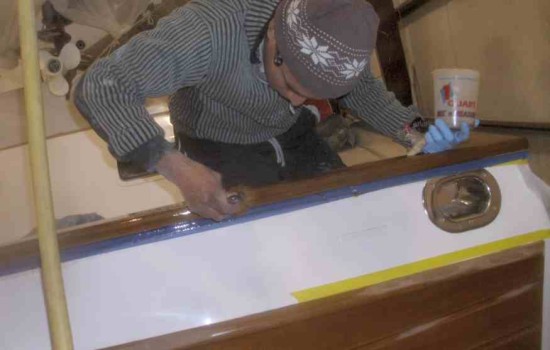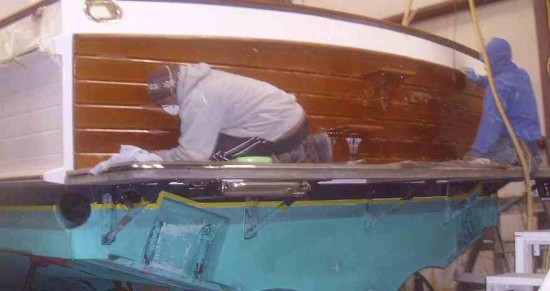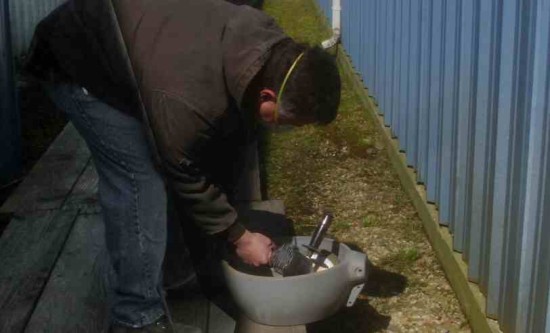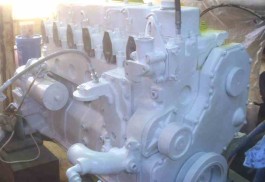We are still looking forward to a warm weekend. It was brisk and breezy this morning however. Our wayward son Kevin decided to grace us with his presence today – I believe the first time this week! I want HIS job.
Varnish work is still ongoing. They are on coat number 4 on the cap rails and after a good sanding in the morning it is looking quite flat now. If you don’t get it flat you’ll never get that look that varnish gives and you may as well be using Cetol or house paint.

The transom also had quite a few dead spots in it but rather than a full strip job, we are chasing the spots. A bit of Interlux 1026 sealer gives these spots almost the same color as the surrounding varnish and they will damned near disappear.

In between the two buildings there was a bit of sun and the wind was efficiently blocked enough for Rumsey to go outside and take advantage of it to do some small part sanding.

The Cummins is almost done. We are waiting for the injectors to come back from the injector shop and then can put all the small parts back together.

 Anything Can Happen Friday
Anything Can Happen Friday
Some thoughts on the common #2 pencil. I was watching a You Tube video of a Russian doing some wood turning and noticed he was using the same yellow pencils I have in my shop. This led me to Wikipedia to learn something about pencils (too much time on my hands?).
External colour of pencils
The majority of pencils made in the US are painted yellow. According to Henry Petroski, this tradition began in 1890 when the L. & C. Hardtmuth Company of Austria-Hungary introduced their Koh-I-Noor brand, named after the famous diamond. It was intended to be the world’s best and most expensive pencil, and at a time when most pencils were either painted in dark colours or not at all, the Koh-I-Noor was yellow. As well as simply being distinctive, the colour may have been inspired by the Austro-Hungarian flag; it was also suggestive of the Orient at a time when the best-quality graphite came from Siberia. Other companies then copied the yellow colour so that their pencils would be associated with this high-quality brand, and chose brand names with explicit Oriental references, such as Mikado (renamed Mirado) and Mongol.
Not all countries use yellow pencils. German and Brazilian pencils, for example, are often green, blue or black, based on the trademark colours of Faber-Castell, a major German stationery company which has plants in those countries. In southern European countries pencils tend to be dark red or black with yellow lines, while in Australia they are red with black bands at one end. In India the most common pencil colour scheme was dark red with black lines, and pencils with a large number of colour schemes are produced by various companies.
Notable pencil users
- Thomas Edison had his pencils specially made by Eagle Pencil. Each pencil was three inches long, was thicker than standard pencils and had softer graphite than was normally available.
- Vladimir Nabokov rewrote everything he had ever published, usually several times, by pencil.
- John Steinbeck was an obsessive pencil user and is said to have used as many as 60 a day. His novel East of Eden took more than 300 pencils to write.
- Vincent van Gogh used only Faber pencils as they were “superior to Carpenters pencils, a capital black and most agreeable”.
- Johnny Carson regularly played with pencils at his Tonight Show desk. These pencils were specially made with erasers at both ends to avoid on-set accidents.
- Roald Dahl used only pencils with yellow casing to write his books. He had 6 sharpened pencils ready at the beginning of each day and only when all 6 pencils became unusable did he resharpen them.

 Anything Can Happen Friday
Some thoughts on the common #2 pencil. I was watching a You Tube video of a Russian doing some wood turning and noticed he was using the same yellow pencils I have in my shop. This led me to Wikipedia to learn something about pencils (too much time on my hands?).
External colour of pencils
Anything Can Happen Friday
Some thoughts on the common #2 pencil. I was watching a You Tube video of a Russian doing some wood turning and noticed he was using the same yellow pencils I have in my shop. This led me to Wikipedia to learn something about pencils (too much time on my hands?).
External colour of pencils





